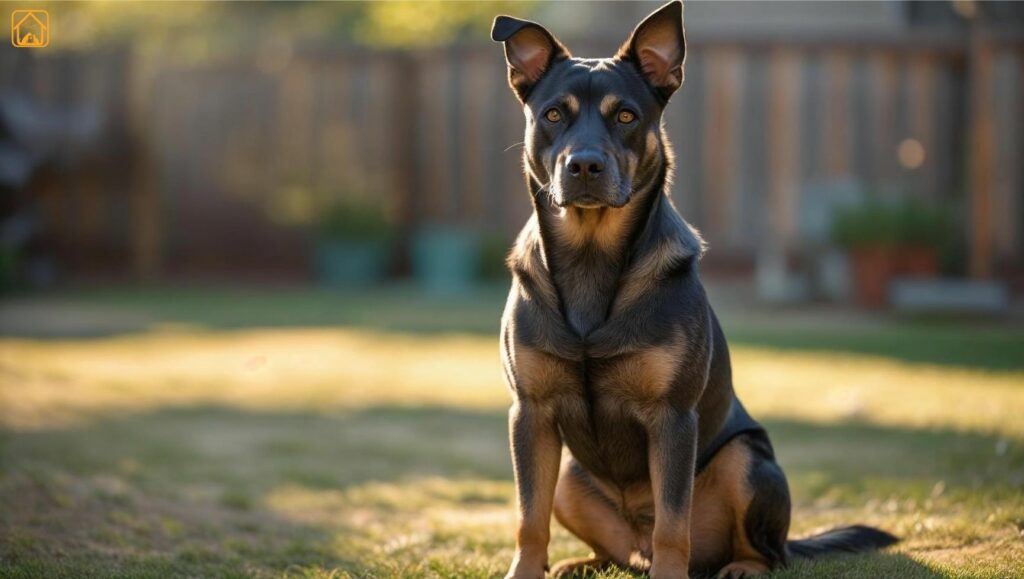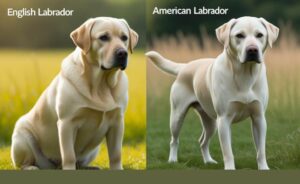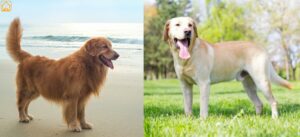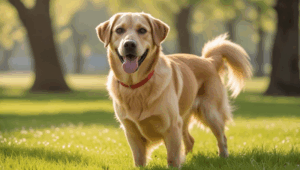What is a Labrador and German Shepherd Mix? (Sheprador Overview)
The labrador and german shepherd mix, often called the Sheprador, German Sheprador, or Labrashepherd, combines two of America’s most beloved breeds into a friendly, energetic, and smart companion. This hybrid brings the affectionate nature of the Labrador Retriever and the loyal, protective instincts of the German Shepherd together.
Shepradors are medium to large dogs, typically weighing between 60 to 95 pounds and standing 20 to 27 inches at the shoulder. You might notice a mix of features: some have the iconic Shepherd ears, while others inherit the Lab’s classic floppy ears and big, soulful eyes. Their coats can be black, chocolate, tan, golden, or even a blend, and most have a dense, double-layered fur that sheds, sometimes a lot. (You’ll want a good vacuum, trust me!)
- Other common names: German Shepherd and Labrador Retriever mix, GSD Lab mix, German Lab mix, Lab Shepherd cross, mix breed of German Shepherd and Labrador
- Average lifespan: 10–12 years
- Best for: Active families, singles, and anyone who loves outdoor adventures
Why do people love Shepradors? Aside from their good looks, they’re known for being loyal, playful, protective, and incredibly smart. Many pet parents say they’re the perfect blend of fun-loving and best guardian, a true heart-stealer who’ll keep you on your toes.
Origin and History of the German Shepherd Lab Mix
The Labrador and German Shepherd Mix originated in North America in the late 20th century, as designer dogs became popular. Breeders intentionally crossed the German Shepherd Dog and Labrador Retriever to combine their best qualities and to reduce the risk of some health issues seen in purebreds.
The Sheprador was bred to combine the Lab’s good-natured, sociable spirit with the Shepherd’s intelligence and protective streak. This resulted in a dog that thrives as a family companion, working partner, or even therapy and service animal.
But here’s the twist, Shepradors aren’t recognized by major kennel clubs like AKC since they’re a crossbreed, but that hasn’t stopped them from stealing the spotlight in homes and shelters everywhere. If you’re looking for a unique, loving companion, you might just find your match in a german shepherd labrador mix.
Physical Characteristics & Appearance
Honestly, no two Shepradors are exactly alike. But there are some common threads that run through this wonderful mix. The German Shepherd and Labrador Retriever mix is a sturdy, athletic dog. Most Shepradors weigh between 55 to 90 pounds and stand 20 to 27 inches tall at the shoulder. Their build can be lean and muscular like a German Shepherd or more solid and broad like a Lab.
Coat and Colors

- Double coat: dense and water-resistant, often short to medium length
- Colors: black, yellow, tan, chocolate, cream, sable, or a mix (including the popular black Lab German Shepherd mix puppies)
- Eyes: expressive and alert, usually brown or amber
| Trait | Sheprador Typical Range |
| Height | 20–27 inches |
| Weight | 60–95 pounds |
| Coat | Short to medium, dense double coat |
| Colors | Black, chocolate, tan, cream, golden, sable, blends |
| Eyes | Brown, hazel, amber |
| Ears | Floppy, semi-upright, or one of each! |
Every Sheprador is a bit of a surprise package, sometimes you get the Lab’s blocky head, sometimes the Shepherd’s upright ears. I’ve met Shepradors that look like Labs in a Shepherd’s jacket, and vice versa!
Temperament and Personality: What to Expect
This is where the labrador and german shepherd mix truly shines. Ever noticed how your dog waits by the door when you’re sad, or bounces up the minute you grab a leash? Shepradors are tuned in to their people. They’re loving, energetic, and fiercely loyal, ready to play fetch for hours or curl up for movie night.
Let’s break down what you can expect:
- Loyalty and devotion: These dogs form strong bonds with their families. Many are natural protectors, alerting you to strangers but quick to warm up to friends. (You’ll feel safe with a Sheprador around.)
- Playful energy: Shepradors are born to move! They love running, hiking, swimming, and chasing balls. Got kids? Perfect, the Sheprador will be their best buddy, always up for a game or a snuggle.
- Intelligence: Both parent breeds are smart, so these mixes are usually quick learners. They thrive on mental challenges, think puzzle toys, hide-and-seek, or scent work.
- Affectionate nature: Don’t be surprised if your Sheprador is a “velcro dog,” following you from room to room, eager for attention. They love being where the action is.
- Protective streak: The German Shepherd side brings a natural watchdog instinct. Most are not aggressive, but they’ll let you know if something’s “off.” Early socialization helps balance their protective side.
- Gentle with children: With proper training and early exposure, Shepradors are famously good with kids. Many owners say their dogs are endlessly patient, even with toddlers in tow.
Of course, every dog is an individual. Some may be more Lab-like (goofy, food-obsessed, friendly with everyone), while others show Shepherd traits (alert, focused, a bit reserved with strangers). Early socialization is key, expose your pup to new people, places, and experiences from day one.
Common behavioral quirks:
- Can be anxious if left alone too long (separation anxiety)
- May be mouthy, chewing toys, shoes, or whatever they find (especially as puppies)
- Occasional stubborn streak, consistency and positive training help
Training, Socialization, and Mental Stimulation Needs
In my opinion, a bored labrador and german shepherd mix is a mischievous Sheprador. These dogs are whip-smart and crave both physical and mental challenges. If you don’t give them a job, they’ll invent one like chewed shoes and surprise holes in the backyard.
Training Shepradors:
- Start early, be consistent, and use positive reinforcement (think treats, praise, and play).
- Teach basic commands, sit, stay, come, leave it, from puppyhood. Shepradors pick up on routines quickly.
- Introduce leash manners right away. These dogs can be strong and excitable on walks.
- Socialize! Bring your dog to meet new people, friendly dogs, and different environments. This helps prevent shyness or overprotectiveness.
- Mix up your training, Shepradors love learning tricks, agility, scent work, and even puzzle games. Challenge their minds as much as their muscles.
Mental stimulation ideas:
- Puzzle feeders or snuffle mats for mealtime
- Hide-and-seek with treats or toys
- Interactive training sessions, teach “find it,” “roll over,” or “shake”
- Regular playdates with other friendly dogs
Remember that positive and patient training builds trust. These dogs thrive when they know what’s expected and are rewarded for good choices. If you’re struggling with a stubborn streak, step back, keep sessions short and fun, and celebrate small wins. (Honestly, some Shepradors act like puppies until they’re two or even three years old!)
Many pet parents find crate training helpful, especially for managing chewing and giving your dog a safe place when you’re away. And if you’re working long hours, consider a dog walker or doggy daycare. Shepradors need companionship and activity, not long lonely days.
Bottom line? Invest time and love into your Sheprador’s training and social life. You’ll get a loyal, well-mannered, and endlessly fun companion in return.
Exercise Requirements & Ideal Living Environment
The labrador and german shepherd mix is an energy powerhouse so how much exercise do they need! Most Shepradors crave at least 60–90 minutes of vigorous movement every single day. It’s not just about burning energy; it’s about keeping their sharp minds busy and their bodies healthy.
- Daily walks: Aim for one long walk (45–60 minutes) plus a couple quick strolls.
- Off-leash play: Secure yards or dog parks are perfect for fetch, frisbee, and zoomies.
- Adventure time: Hikes, swims, and even canine sports (like agility or dock diving) are Sheprador favorites.
- Mental exercise: Mix in training games, food puzzles, or scent work to prevent boredom.
Honestly, a tired Sheprador is a happy Sheprador, and so is a happy pet parent! This breed isn’t a good match for apartment dwellers unless you’re seriously committed to daily adventures and brain games. If you have a big backyard and kids who love to play, you’re golden.
Can they live in an apartment?
It’s possible, but it’s not easy. You’ll need to be super consistent about exercise and give them lots of opportunities to socialize and explore outside. If you live in a smaller space, plan on extra trips to parks and creative indoor games, otherwise, you’ll have a bored, restless dog on your hands.
At the end of the day, this labrador and german shepherd mix just wants to be part of the action. Include them in your adventures, and you’ll have a loyal, joyful companion who’s always game for the next big thing, even if that’s just a muddy walk in the rain.
Diet, Nutrition, and Feeding Guidelines
Feeding a labrador and german shepherd mix is a bit like fueling an athlete, these dogs need quality nutrition to match their active lifestyle. But here’s the catch, both Labs and Shepherds are notorious for being “foodies.” In other words, Shepradors love to eat and can easily gain weight if their portions aren’t kept in check. (Ever seen that “puppy-dog eyes” trick? They’ve mastered it.)
What should Sheprador eat?
Look for a high-quality kibble or fresh food formulated for large, active breeds. Protein is key for muscle maintenance, while balanced fats and carbs keep their energy up. Below is the age-wise feeding schedule.
- Puppies: Feed 3–4 small meals a day, puppies have fast metabolisms and need steady nutrition to grow strong (but not too fast, which can stress their joints).
- Adults: Two meals per day is the sweet spot. Stick to a regular schedule and measure portions to avoid overfeeding.
- Seniors: As activity slows, switch to a senior formula and watch calories to prevent weight gain.
How much to feed a Sheprador?
It depends on your dog’s age, activity, and metabolism, but most adult Shepradors eat between 3–4 cups of food daily, split into two meals. Always check your food’s calorie content and adjust based on body condition , your vet can help dial this in.
Watch-outs:
- Obesity: Both parent breeds are prone to weight gain. Keep treats small to under 10% of required calories healthy and avoid sharing table scraps (no matter how convincing the stare).
- Bloat: Like many large breeds, Shepradors can be at risk for gastric torsion (bloat). Feed smaller meals, avoid vigorous exercise right after eating, and use slow-feeder bowls for gulpers.
- Food allergies: Some Shepradors have sensitive tummies. If you notice itching, ear infections, or tummy troubles, talk to your vet about possible food sensitivities.
Sheprador Daily Feeding Plan:
| Life Stage | Meals/Day | Calories/Day (avg.) |
| Puppy | 3–4 | 1,200–2,000 |
| Adult (60–95 lbs) | 2 | 1,400–2,400 |
| Senior | 2 | 1,000–1,800 |
And don’t forget water, fresh, clean water should always be available. If you’re unsure about brands or portion sizes, check out our detailed guide on Dog Nutrition or ask your vet for recommendations.
Health Issues & Lifespan: Common Concerns in Shepradors
Now for the part every pet parent worries about, health. The good news? The labrador and german shepherd mix is often considered healthier than their purebred parents, thanks to something called “hybrid vigor.” But that doesn’t mean they’re immune to issues. The Average lifespan of Shepradors is 10–12 years (sometimes longer with great care and a little luck).
Common health problems in Shepradors:
- Hip and elbow dysplasia: Both Labs and Shepherds can pass on joint problems. Watch for stiffness, limping, or reluctance to jump. Keeping your dog at a healthy weight and providing joint supplements (if recommended by your vet) can help.
- Obesity: These food-loving pups gain weight easily. Excess pounds put extra strain on the joints and can lead to diabetes, heart problems, and more.
- Bloat (gastric dilatation-volvulus): A sudden, life-threatening swelling of the stomach that requires immediate vet care. Feed smaller meals, limit rough play after eating, and know the warning signs: a distended belly, restlessness, unproductive retching.
- Ear infections: Floppy ears trap moisture. Clean ears regularly and dry them after baths or swims.
- Allergies and skin issues: Itchy skin, hotspots, or ear problems may signal food or environmental allergies.
- Degenerative myelopathy: A rare, progressive spinal cord disease occasionally seen in Shepherds. Symptoms include weakness or wobbling in the hind legs.
- Eye conditions: Cataracts and progressive retinal atrophy (PRA) can affect vision as dogs age.
How to keep your Sheprador healthy?
- Regular vet checkups: Annual checkups catch problems early. Your vet might recommend hip and elbow evaluations, bloodwork, or breed-specific screenings as your dog ages.
- Vaccinations and preventatives: Stay current on vaccines, heartworm meds, and flea/tick control. Prevention is a lot easier (and cheaper) than treatment.
- Weight management: Keeping your Sheprador lean is the single best thing you can do for their joints and longevity. (And ignore the “feed me!” eyes. You’re not mean, you’re loving!)
- Exercise: Regular movement strengthens muscles, supports joint health, and keeps minds sharp.
- Dental care: Brush those teeth! Dental disease is common in all breeds and can lead to bigger health problems if ignored.
Red flags to watch for:
- Limping, stiffness, or “bunny hopping” gait
- Sudden weight gain or loss
- Chronic itching/licking
- Excessive drinking or urination
- Unusual lumps or bumps
If you spot anything odd, play it safe, call your vet. Early intervention makes all the difference.
Grooming and Shedding: Maintaining Your Sheprador’s Coat
Both the German Shepherd and Lab are known for their double coats, and yes, they shed. A lot. Expect regular brushing (at least two to three times a week) to keep shedding under control and your dog’s coat healthy. During seasonal “blowouts,” daily brushing might be needed.
What’s the coat like? Most Shepradors have a dense, double-layer coat that’s short to medium in length. The outer coat repels dirt and water, while the soft undercoat keeps them cozy in winter and helps regulate body temp in summer.
- Brushing: Aim for a thorough brush 2–3 times a week, daily during shedding seasons. Use a slicker brush or deshedding tool to get through that undercoat.
- Bathing: Every 2–3 months, or as needed (like after a muddy adventure!). Overbathing can dry out their skin, so stick with gentle dog shampoos.
- Ears: Check and clean weekly, especially if your dog swims. Floppy ears need extra TLC to prevent infections.
- Nails: Trim every 3–4 weeks, or as soon as you hear clicking on floors.
- Teeth: Brush several times a week (ideally daily), it helps prevent dental issues and bad breath.
Tips for taming the fur tornado:
- Keep a grooming kit handy: slicker brush, undercoat rake, nail clippers, ear cleaner
- Use a high-velocity dryer (if your dog’s cool with it) to blast out loose fur during shedding seasons
- Vacuum and lint roll regularly, embrace the “dog hair, don’t care” life!
If you have allergies, this mix might not be your best match. For everyone else, a little routine grooming goes a long way toward keeping your labrador and german shepherd mix looking (and smelling) fabulous.
Is the Labrador German Shepherd Mix Right for You? Adoption Tips & FAQs
Thinking about bringing a labrador and german shepherd mix home? Let’s have a real talk. These dogs are amazing, but they aren’t for everyone. Here’s a quick gut-check before you fall completely in love:
- Do you have the time and energy for daily activity?
- Are you ready for some shedding (and maybe a little drool)?
- Can you commit to training, socialization, and companionship?
- Is your home (and heart) ready for a big, goofy, loyal friend?
- If you work long hours or travel a lot, have you considered dog walkers or daycare?
If you answered Yes, you’re in for an adventure! Shepradors are loyal, loving, and endlessly fun, but they need structure, exercise, and lots of love. They shine in active families, with singles who love the outdoors, or as loyal buddies to older kids. If you’re looking for a low-maintenance couch potato, though, you might want to check out a calmer breed.
Adoption tips:
- Check local shelters and rescue groups, many labrador and german shepherd mix dogs end up in rescue through no fault of their own.
- Ask about temperament, energy level, and any training history.
- Meet a few dogs before deciding, every Sheprador is wonderfully unique.
- Consider fostering first if you’re unsure about the commitment.
FAQs About the Labrador and German Shepherd Mix
Are Shepradors good with kids?
Absolutely! With early socialization and supervision, they’re gentle, playful, and endlessly patient. Always teach children how to respect dogs and never leave young kids unsupervised.
Can Shepradors live with other pets?
Usually yes, especially if socialized early. They tend to be friendly with other dogs and sometimes even cats, but watch for Shepherd-like herding or chasing instincts. Early introductions are key.
How much do Shepradors shed?
Get ready for fur. These dogs shed year-round and “blow” their coats twice a year. Regular brushing helps, but you’ll still find hair on your clothes and couch. It’s part of the package!
Are Shepradors easy to train?
Yes! They’re smart, eager to please, and love learning new things. Positive reinforcement works wonders. Just be patient, some can be stubborn, especially as teenagers.
Do Shepradors bark a lot?
They can be vocal, alerting you to visitors or new noises. With training and enough exercise, most aren’t excessive barkers, but they will “talk” when bored or excited.
How big will my Sheprador get?
Most are 60–95 pounds and 20–27 inches tall, but size can vary depending on genetics. Ask your rescue or breeder about the parents for a better guess.
Where can I find a Sheprador to adopt?
Start with local shelters, German Shepherd or Labrador rescues, and pet adoption sites. Many wonderful mixes are waiting for their forever homes!
Conclusion
Final thought? If you’re ready for an energetic, loving, and totally unforgettable best friend, the labrador and german shepherd mix will steal your heart, and probably your spot on the couch, too.



